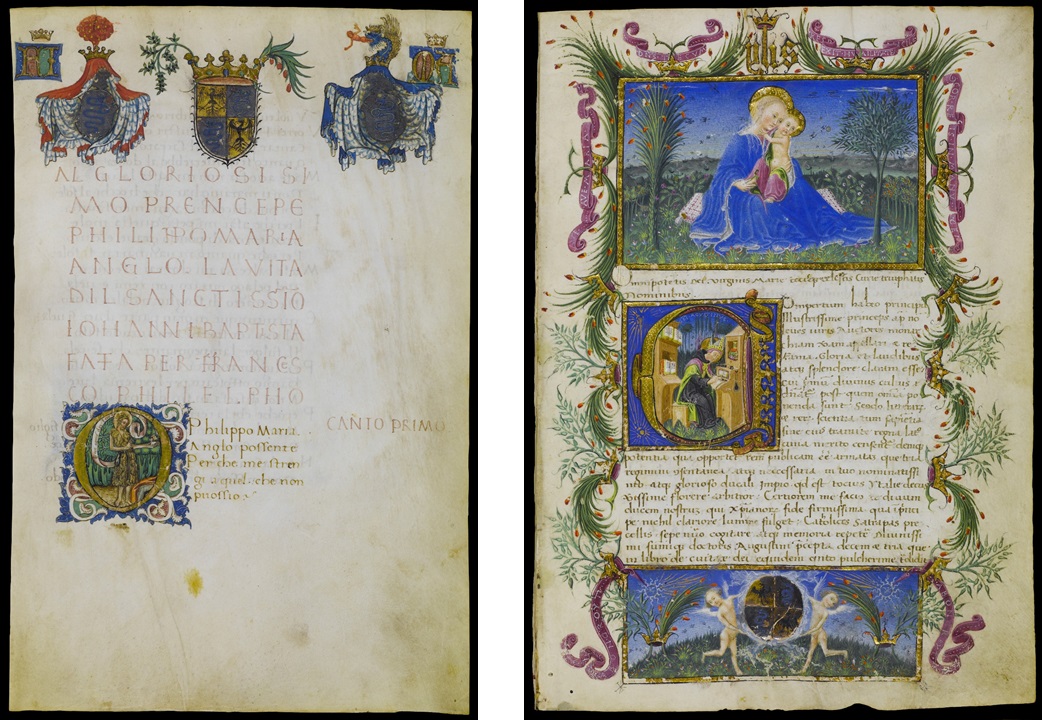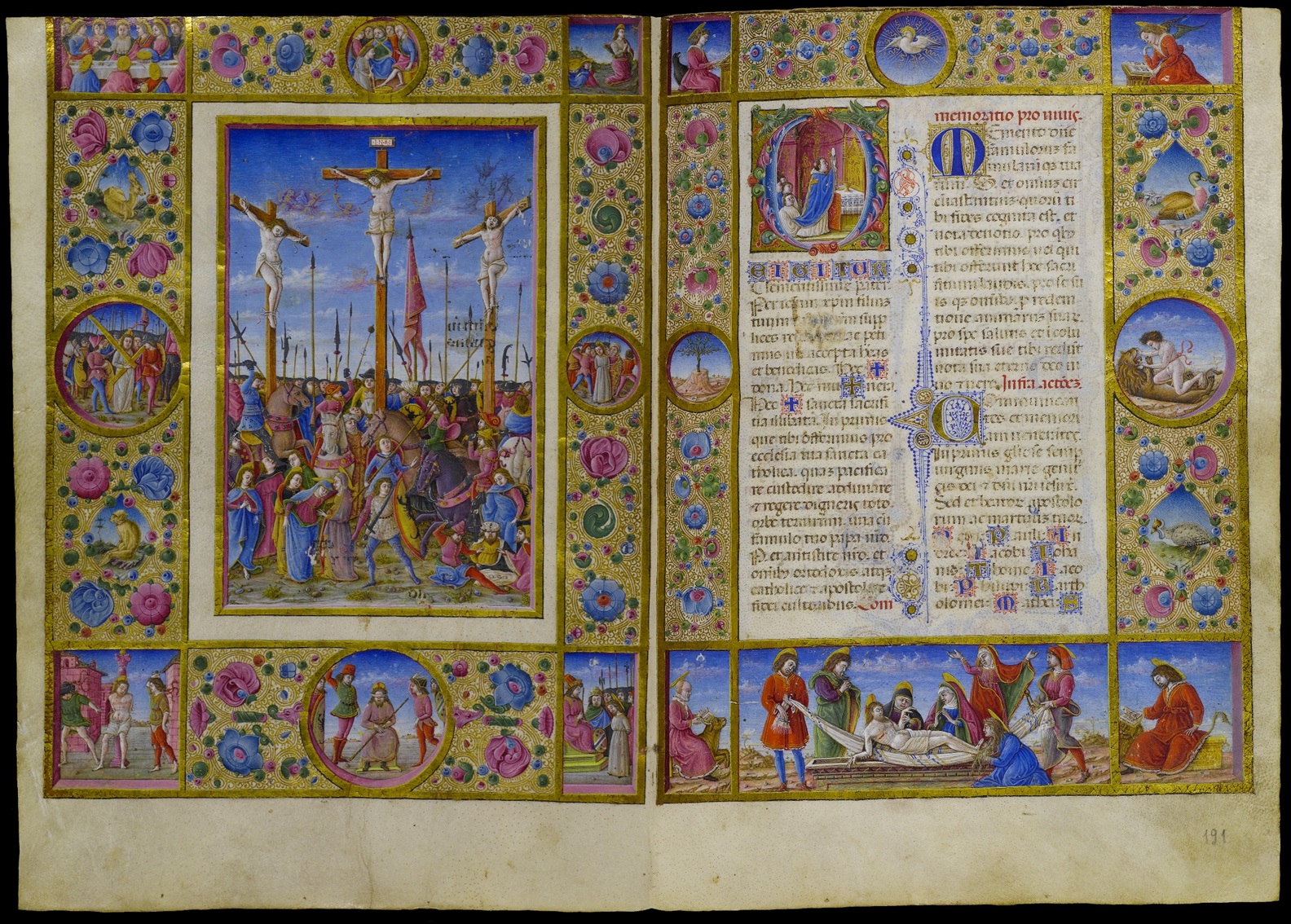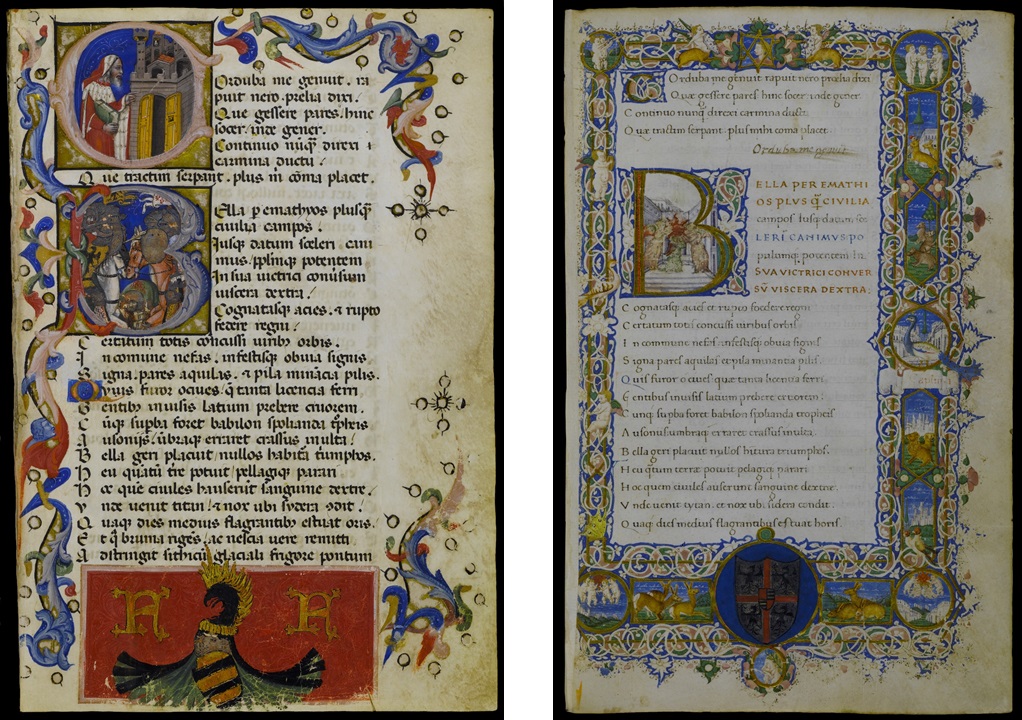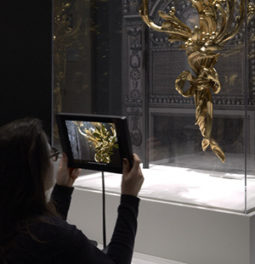
Frontispiece from Suetonius’s Lives of the Twelve Caesars, Maestro delle Vitae Imperatorum, for Bartolomeo Aicardi Visconti, 1444. Archivio Storico Civico e Biblioteca Trivulziana Cod. Triv. 696, fol. 1 (© Comune di Milano. All rights reserved.)
The Getty exhibition Renaissance Splendors of the Northern Italian Courts has a twin, parallel exhibition in Milan at the castle of the once-great ruling Sforza family. Bearing the same name (though in Italian), Splendori rinascimentali nelle corti dell’Italia settentrionale is organized by the Archivio Storico Civico e Biblioteca Trivulziana in coordination with Bryan Keene of the Getty’s Manuscripts Department. The show, open through July 21, offers visitors a chance to enjoy the artistry of illuminated books produced in the most important courts of northern Italy. Each object tells many stories of artists, patrons, and artistic styles.
All of the manuscripts in the show come from the collection of the Biblioteca Trivulziana, one of Italy’s great rare-book libraries, and can be viewed online in the Getty’s Google Open Gallery virtual exhibition, along with works from other northern Italian collections.
Milan and Lombardy
The exhibition at the Castello Sforzesco opens with a rich selection of manuscripts and incunabula (early printed books) illuminated in Milan or in the broader region of Lombardy. Some of the books were commissioned by famous individuals from the Visconti-Sforza family, such as Filippo Maria Visconti, duke of Milan from 1412 to 1447, and Bartolomeo Aicardi Visconti, bishop of Novara from 1429 to 1457. Yet more manuscripts are on view in the nearby Sala del Tesoro of the Sforza Castle, where visitors can view seven additional manuscripts of Visconti-Sforza provenance collected in the second half of the 18th century by Don Carlo Trivulzio, after whom the library is named.

Left: Initial O: Saint John the Baptist in Francesco Filelfo’s Life of Saint John the Baptist, Lombard Illuminator, for Filippo Maria Visconti, 1445. Archivio Storico Civico e Biblioteca Trivulziana, Triv. 732, fol. 1 (© Comune di Milano. All rights reserved.) Right: The Virgin and Child; Initial C: Saint Augustine in Martino Garati’s Treatise on Princes, Pietro di Giovanni d’Ambrogio, for Filippo Maria Visconti, 1446–47. Archivio Storico Civico e Biblioteca Trivulziana, Triv. 138, fol. 1 (© Comune di Milano. All rights reserved.)
The manuscripts in this section of the exhibition were illuminated by famous and anonymous artists alike, such as Ambrodio da Cermenate, the Master of the Vitae Imperatorum, the Master of the Birago Hours, the Master B.F., and others. Together, this group demonstrates the stylistic development of illumination in Lombardy from the late Gothic period well into the Renaissance. The first two manuscripts in this section, for example, are attributed to the Master of the Vitae Imperatorum, one of the most noted artists in Lombardy in the first half of the 15th century, whose figurative style was still late Gothic. The last and largest manuscript (shown below) transports visitors to the middle of the 16th century; this choir book was made for the Basilica of San Vittore al Corpo in Milan and decorated by the anonymous Master B.F.

Initial L: The Nativity, Master B. F., about 1542–45. Archivio Storico Civico e Biblioteca Trivulziana, Milan, Corale A, fol. 33 (© Comune di Milano. All rights reserved.)
Ferrara
The exhibition continues with three display cases containing manuscripts prepared and decorated for the Este family, marquises and later dukes of Ferrara. The small volume on good government decorated by Taddeo Crivelli for Borso d’Este demonstrates the significant role played by illuminators at the Ferrarese court, and Ercole I d’Este’s Missal is one of the greatest examples of the Ferrara school of illumination from the 1470s.

The Crucifixion; Initial T: A Priest Celebrating Mass from Missal, Martino da Modena with Giorgio d’Alemagna and Bartolomeo del Tintore, 1470, for Ercole I d’Este. Archivio Storico Civico e Biblioteca Trivulziana, Milan, Cod. Triv. 2165, fol. 191 (© Comune di Milano. All rights reserved.)
Mantua
The Gonzaga dynasty is represented in two exquisite illuminated manuscripts of the Pharsalia of Lucan, a Roman epic poem about the civil war between Julius Caesar and Pompey the Great. The first copy, completed in 1373, was illuminated by Nicolò da Bologna and owned by Francesco Gonzaga, the ruler of Mantua from 1366 to 1407. The second copy was written and illuminated by Raffaele Berti of Pistoia on July 26, 1456, while the author-illuminator was in prison at the Gonzaga court.

Left: Initial C: The Poet Lucano; Initial B: The Encounter between Caesar and Pompey in Lucanus’s Pharsalia, Niccolò da Bologna, for Francesco Gonzaga, 1373. Archivio Storico Civico e Biblioteca Trivulziana, Triv. 691, fol. 3 (© Comune di Milano. All rights reserved.); Right: Initial B: Three Angels Holding the Sun in Lucanus’s Pharsalia, Raffaele Berti, for Ludovico III Gonzaga, 1456. Archivio Storico Civico e Biblioteca Trivulziana, Triv. 692, fol. 1 (© Comune di Milano. All rights reserved.)
Venice and Its Surroundings
The exhibition ends with a fine selection of manuscripts and printed books from the Veneto region and represents the work of some of the most significant artists active in Verona, Padua, and Venice in the second half of the 15th century. The examples on display were illuminated by famous names such as Felice Feliciano, Giovanni Vendramin, Francesco Dai Libri, and the Master of the Putti.
These examples show a vast, cultured repertory of imagery drawn from antique sources, demonstrating the enthusiastic taste for the ancient world that was widespread in the Veneto at that time. A good example is the opening page of Petrarch’s Triumphs, printed in Padua by Bartolomeo da Valdezocco and Martino de Septem Arboribus in 1472. The text is printed in capital letters and decorated with classical motifs against a red background. At the bottom of the page, the so-called Master of the Putti depicts The Triumph of Bacchus and Ariadne with figures inspired by a Roman sarcophagus.

The Triumph of Bacchus and Ariadne in Francesco Petrarch’s Rhymes and Triumphs, Maestro dei Putti, for Basadona Family, 1472. Archivio Storico Civico e Biblioteca Trivulziana, Inc. Petr. 2, fol. 140 (© Comune di Milano. All rights reserved.)
Text of this post © Marzia Pontone. All rights reserved.




Comments on this post are now closed.